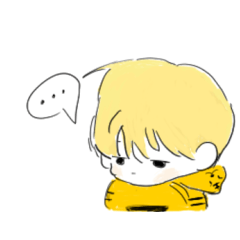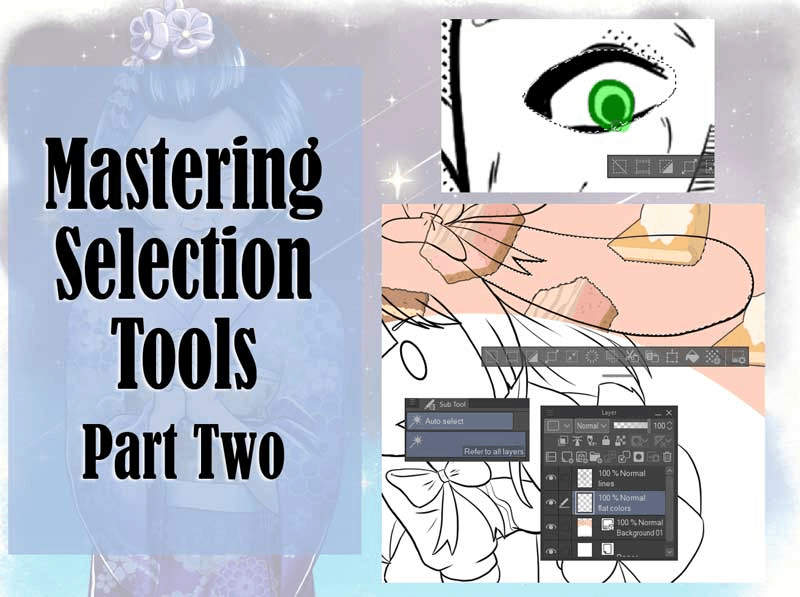Mastering vector layers
Compatible with Clip Studio Paint Ver. 1.10.0
[1] What are vectors?
The “Raster format” commonly used in drawing software stores an image’s information by placing dots on the individual cells of a grid.
Clip Studio Paint's “Raster layer” also saves images in this format.
Because of how they work, raster images display artifacts called “Jaggies” when scaled.
“Vector format” images record the starting point, ending point, and curvature of a line.
Along with this information, in Clip Studio Paint, pen pressure is also recorded. As the lines are recalculated and redrawn when zoomed in, “Jaggies” do not appear. A “Vector layer” stores images in this format.
When a vector line is selected with the [Object] sub tool of the [Operation] tool, boxes connected with a thin line are displayed at the center of the line.
The line at the center of the drawn line is called a “Path” and an individual point on the path is called a “Control point”.
Elements such as a line’s curvature can be adjusted by dragging and dropping a section (or all) of the line.
Additionally, erasers that can erase lines up to an intersecting point can be used.
When working on line art, the vector format can provide various advantages.
However, there is a disadvantage that the [Fill] tool and [Gradient] tool cannot be used, and colors cannot be mixed.
Note:By exporting vector layer data made in Clip Studio Paint to the SVG format, you can load it into vector editing software (drawing software) such as Illustrator.
Note: SVG (Scalable Vector Graphics) files are a type of 2D vector data file format which do not lose image quality when scaled up or down.
The SVG files exported by Clip Studio Paint only contain line data.
See below for details on how to import and export SVG files.
[2] Making vector layers
In Clip Studio Paint, dedicated vector layers are used when drawing in vector format.
① Click the [New vector layer] button in the [Layers] palette to create a vector layer.
② An icon will be displayed on the new vector layer.
Note: The “make new layer” command can also be found in the menu.
① Select [New Layer] → [Vector Layer] from the [Layer] menu.
② In the [New Layer] dialog box, set the layer name/expression color/layer blend mode.
[3] Vector eraser
Lines drawn on a vector layer can be freely erased with the [Eraser] tool, similar to a [Raster] layer.
Furthermore, with vector layers, it is also possible to use erasers in a way that takes advantages of the characteristics of the vector format.
Here we will show how to use one of the most useful functions of the vector format: the “Intersect delete”. With this function, you can draw objects with multiple intersections (such as buildings) efficiently and cleanly.
① Draw something such as a window without stopping at an intersection, leaving an extended line.
②Select the [Eraser] tool, then the [Vector] from the [Sub Tool] palette.
③ Select [Erase up to intersection] from the [Vector eraser]’s [Tool Property] palette.
④ Touching any part of the intersecting lines with the eraser will erase the lines up to an intersection.
[4] Changing the line weight
In Clip Studio Paint, the “weight” of vectors can be changed. Emphasis and nuance can be added to a uniformly thick line.
① Select the [Edit line] tool, and select [Correct line width] from the [Sub Tool] palette.
② In [Tool Property], select either [Scale up width] or [Scale down width].
③ Specify the area to change width by painting with the brush (the green part below).
If [Scale up width] is selected from [Tool Property], you can correct the line to become thicker.
If [Scale down width] is selected from [Tool Property], you can correct the line to become thinner.
For example, you can draw background line art with a uniform width and add nuance later.
As seen here, all lines drawn on a vector layer can be edited afterwards.
[5] Controlling lines with the [Operation] tool
Lines can be controlled by using the [Object] sub tool of the [Operation] tool.
① Select the [Object] sub tool from the [Operation] tool.
② When you select a line drawn on a vector layer, the path, control points, and a bounding box are displayed. Using these, the line can be controlled.
■ Basic line operation
Objects can be scaled up or down by moving the corners handles of the bounding box.
Moving the top control point will rotate the object.
The shape of the object can be edited by dragging the control points.
■ Changing line selection methods
The line selection method can be set with [Operation] > [Operation of transparent part] > [Select area by dragging].
If [Select area by dragging] is unselected, only one line can be selected per click.
If [Select area by dragging] is selected, multiple lines can be selected by dragging.
Note: When [Vector] in [Selectable object] is turned off, lines on the vector layer cannot be selected.
When you cannot select lines on the vector layer, check this option.
■ Selecting operation
The editing method can be chosen from the [Mode] options.
Each option and the corresponding controls are as follows.
① [Control point and scale/rotate]
The bounding box and control points can be operated.
② [Move control point]
The control points can be operated.
③ [Scale up/Scale down/Rotate]
The bounding box can be operated.
④ [Free Transform]
Operates the bounding box.
■Color/Brush size/Brush shape
[Main color/Sub color]
The selected line color can be set as the [Main color]. When using a brush with a sub color, the sub color can be adjusted as well.
[Brush Size]
The selected line width can be changed with [Brush Size].
[Brush shape]
The selected line pattern can be changed with [Brush shape].
[6] Operating lines with the [Correct line] tool
Tools to operate vector layer lines are in the [Correct line] sub tool of the[Edit line] tool.
A. Control point
Lines drawn in the vector format are made from a “Path” and “Control points”. The [Control point] sub tool adjusts control points.
From [Content of process] in [Tool Property], choose the control point adjusting method.
Regardless of the process content, if you place the cursor over the line, the path and control point will be displayed and become editable.
Details of each content of process are as follows.
Move control points by dragging and dropping.
① [Move control point]
② [Add control point]
By clicking on a path where the “+” cursor is displayed, a control point is added.
③ [Delete control point]
By moving the cursor to a control point you wish to delete and clicking when the cursor is a “-”, the control point will be deleted.
④ [Switch corners]
By clicking on a control point, the paths coming from the control point can be switched between curves and straight lines.
⑤ [Correct line width]
By dragging the cursor left when the cursor changes above a [Control point], the line width becomes [thin], while dragging to the right will make it [thick].
⑥ [Correct density]
By dragging the cursor left when the cursor changes above a [Control point], the line opacity becomes [lower], while dragging to the right will make it [higher].
⑦ [Cut line]
By clicking on a [Control point], a path can be cut.
B. Pinch vector line
The pinch vector line sub tool can drag and retouch a line as if pinching it.
・[Fix end]
Select whether to fix the end points with [Fix end], and retouch the line’s curve by dragging the line.
・[Pinch level]
Adjust the level of bending.
・[Effect range]
Adjust the size of the pinched area.
C. Simplify vector line
Convert the line art drawn on the vector layer to a simpler line.
・Simplify
Adjust the amount of simplification. The specifics of the simplification can be set by turning [Round corners] and [Process whole line] on and off.
・Delete shorter line
Lines under a specific length can be deleted as short lines when simplifying.
・Brush Size
Adjust the size of the brush that specifies the line.
D. Connect vector line
Connect two lines drawn on a vector layer.
・Simplify
When connecting lines, simplify will be applied. The specifics of the simplification can be set by turning [Round corners] and [Process whole line] on and off.
・Connect lines
If this setting is turned off, lines cannot be connected. When specifying a gap while on, the gap will be recognized and connected.
・Brush Size
Adjust the size of the brush that specifies the line.
E. Correct line width
Change the width of a vector line.
・[Thicken/thin width]
The line will be thickened (thinned) a specified length from the line’s outline. With tapered lines, the tip will be rounded.
・[Scale up/down width]
Thicken(thin) the line based on the current width and a specified scale. Even with tapered lines, the tip will not be rounded.
Note: [Thicken/thin width] can be applied to raster layers as well. As the line will disappear if thinned too much, turning [Leave a line of 1 pixel] on is recommended.
F. Redraw vector line
Change a drawn vector line by tracing over it with a pen. The options can be set in a similar fashion as the other tools.
G. Redraw vector line width
Trace a vector line to change its width.
Change the line width to the width specified by the [Brush Size]. It can also be set to correspond with pen pressure.
[7] Creating rulers from vectors
With the [Layer] menu > [Ruler/Frame] > [Ruler from vector] command, you can create a ruler shaped like a selected vector line.
Using this, you can redraw lines with pressure along the ruler.
Also, if the ruler is a closed shape, you can select the inside of the line by using the [Selection from Ruler]command.
▲[Layer]menu > [Ruler/Frame] > [Selection from Ruler]
























Comment